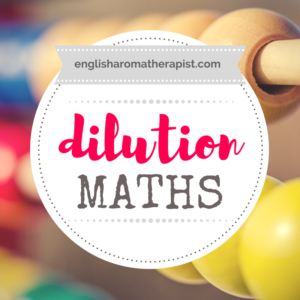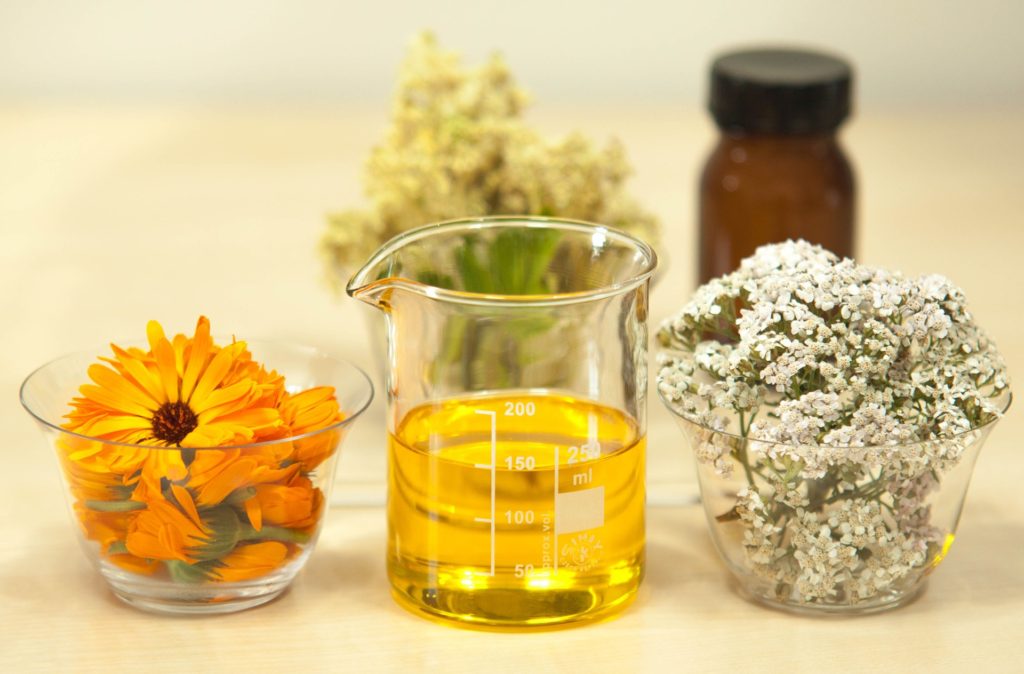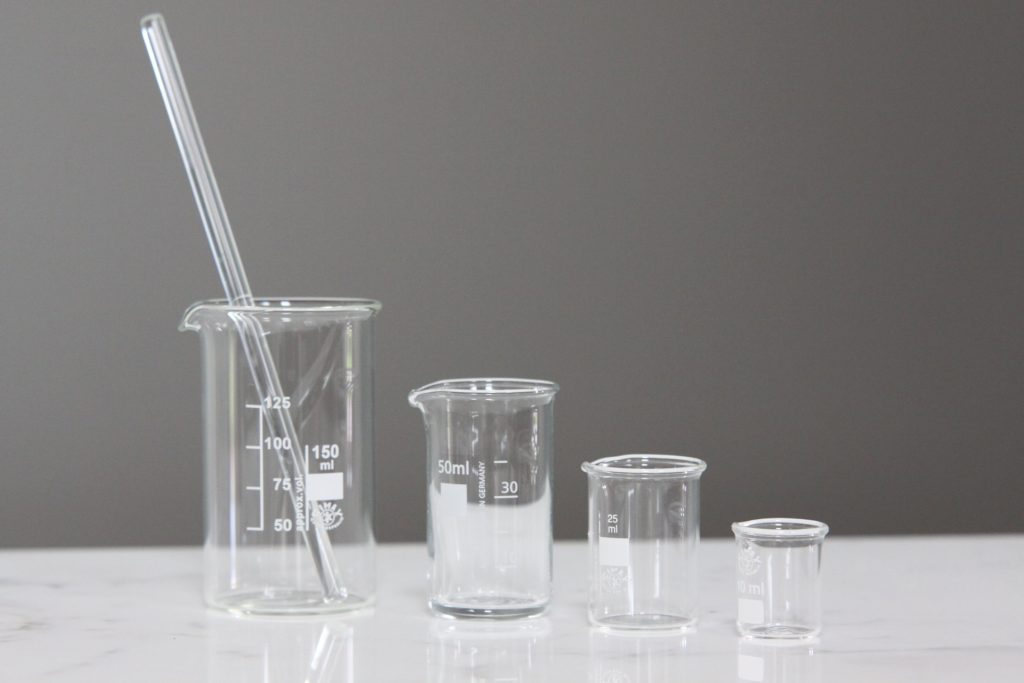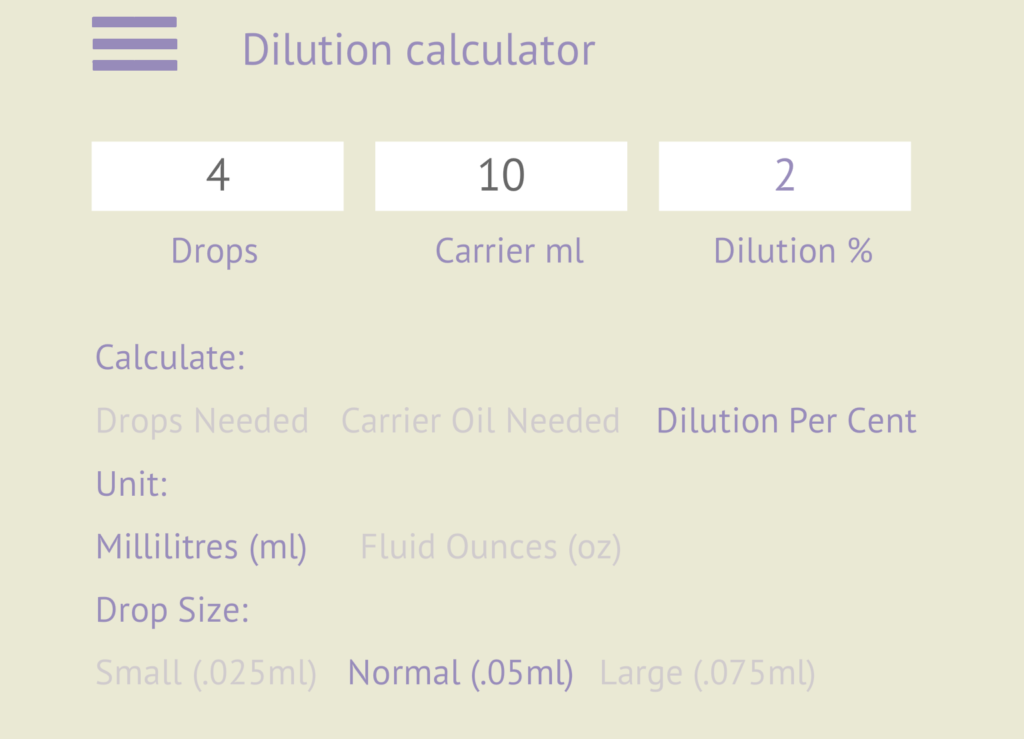Dilution Maths

If you add 10ml essential oil to 10ml carrier oil – what would be the dilution of the blend?
… 50%?
… or 100%?
Dilution is probably one of the most misunderstood aspects of aromatherapy.
It’s safe to say there’s a lot of confusion about dilution in general. This article isn’t about WHY you should dilute essential oils – I’ve already covered this here.
Let’s focus on dilution maths. Wait – don’t back away. I’m not a fan of maths either! And I’m going to make this as simple as possible.
First of all – what do we mean by dilution of essential oils?
What is Dilution?
Aromatherapy dilution is not “normal dilution”. Try explaining to a mathematically-minded app developer how to calculate an essential oil dilution, and you’ll soon realise that aromatherapy dilution is different. When we developed my Essential Oil Blending app, we ended up calling it “aroma maths”!
Let me explain.
Unlike “normal dilution”, the aromatherapy dilution percentage reflects the amount of essential oil that’s been ADDED to the carrier oil – it’s not a percentage of the total content.
A 10% blend means 10% of the carrier oil quantity has been added to it in the form of essential oil. It does not mean that 10% of the total blend is comprised of essential oil.
So, let’s say we start off with 100ml of carrier oil, and we want to make a 10% blend. We will be ADDING 10% of 100ml. This would be 10ml of essential oil.
This means we now have a bottle that contains a total quantity of 110ml. It’s a 10% blend – but it is not true to say that essential oil makes up 10% of the total blend (because 10% of 110ml equals 11ml).
Who cares?
You could be forgiven for thinking this is just a case of splitting hairs. After all, as long as we know how many drops to use in order to make a safe dilution, does it really matter?
Well, it does matter when you start to increase the dilution. At a low percentage, the difference between “normal dilution” and “aroma maths” is negligible. But, once you go beyond 20% the discrepancy increases.
This table shows how the gap starts to widen as the dilution percentage increases:
| Essential Oil (ml) | Carrier Oil (ml) | Quantity (ml) | Normal Dilution | Aroma Maths |
| 1 | 100 | 101 | 0.99% | 1% |
| 2 | 100 | 102 | 1.96% | 2% |
| 10 | 100 | 110 | 9.09% | 10% |
| 25 | 100 | 125 | 20% | 25% |
| 50 | 100 | 150 | 33.33% | 50% |
| 100 | 100 | 200 | 50% | 100% |
| 200 | 100 | 300 | 66.67% | 200% |
Example: Let’s say we add 50ml essential oil to 100ml carrier oil. This makes a total of 150ml, and essential oil comprises one-third of it. So you’d think this was a 33.3% blend. But the table shows that – in “aroma maths” – it’s actually classed as a 50% dilution.
And what if we add 200ml essential oil to 100ml carrier oil? Is this blend two-thirds essential oil (66.6%) or is it a 200% dilution?

What is “aroma maths”?
It’s easy to see why aromatherapy dilution can be confusing.
If we add 8ml of essential oil to 10ml of carrier oil – the dilution is 80%
If we add 9ml of essential oil to 10ml of carrier oil – the dilution is 90%
But what if we add 10ml of essential oil to 10ml of carrier oil – is the dilution 100%?
…Or is it 50%?
…After all, it’s a blend that’s 50/50 carrier oil and essential oil. It’s correct to say that half the blend is essential oil. So the bottle contains 50% essential oil – as a “normal dilution” we’d say this is 50%. But in “aroma maths” it’s actually a 100% dilution.
This is why we end up with blends that exceed 100%!
Brain fried?
I’ve tried to explain this as simply as possible. Essentially, as long as you understand the basics of how to make a safe dilution, you don’t need to worry about it.
Luckily, there are lots of handy dilution charts that show these calculations at a glance. Just make sure you’re using a dilution chart from someone who understands what dilution actually means! (You’ll find one in The Little Book of Dilution)
As the table above shows, someone could easily assume a blend is a 50% dilution (using normal dilution) when it’s actually a 100% dilution using aroma maths!
Perhaps it’s easier to think about how much to ADD, rather than how much to dilute. In other words, it’s easier to say “for every 10ml of carrier oil, add 4 drops of essential oil” rather than “dilute the essential oils to 2%”.
If you’re looking for an interactive tool, don’t forget my Essential Oil Blending app contains a dilution calculator, which easily allows you to work out any oil dilution.
Also, check out The Aroma App, which allows you to submit blends and automatically calculates the dilution for each one.

While we’re here, let’s clear up a few other common dilution questions…
“High dilution”?
The terminology can be confusing, so it’s not surprising some people get dilution ratios the wrong way round. Is it a strong/weak dilution, or a high/low dilution? This “Oil Academy” is using the opposite logic to represent essential oil dilution.
Some believe a “higher dilution” means a dilution with a higher number – therefore, a 90% dilution appears to be a higher dilution than a 2% blend. It sounds higher, right?
Actually, it’s the other way round. If something is highly diluted, it will be less concentrated – so it will have a lower dilution percentage. In other words, a 2% blend will be more highly diluted than a 90% blend.
The lower the dilution %, the more diluted the essential oil is…which is why aromatherapists tend to stick to blends below 5% for regular use.
Max dermal limits?
According to Essential Oil Safety (2nd Edition) by Tisserand & Young, some essential oils have specific maximum dermal limits.
How do we safely blend different oils with varying dermal limits? For example, if the recommended dermal limit of lemongrass is 0.7%, how do we factor this into making a 10ml blend including other essential oils?
The easiest way is to check the dilution of each ingredient. In my dilution calculator, choose the ‘Drops Needed’ option. Enter your dilution (0.7%) and the amount of carrier oil (10ml). You’ll see that 1.4 drops is the maximum amount of lemongrass that should be used for that quantity of carrier oil. Obviously we can only work with whole drops, so just round it down to 1 drop.
This way, you’ll know that lemongrass is included in the blend at a safe dilution. Obviously, you will need to make sure the remaining essential oils in the blend do not exceed the recommended total dilution.
Half drops?
Trying to calculate fractions of drops can be tricky. You might find it easier to just mix up a larger master blend. For example, if a blend calls for 1.5 drops of lemongrass you could just double the quantity of all ingredients and use 3 drops of lemongrass instead.

Multiple dilutions?
If you’re blending with more than one essential oil, the dilution reflects the TOTAL amount of essential oils in that blend. So, if you add 1% lavender and then 2% geranium, the overall dilution will be 3%.
Want to know more?
If you fancy delving deeper into this, look up dilution factors and dilution ratios! Bit of light reading for you… 🙂
What to read next: The Little Book of Dilution
Follow me on...
Share this on...
